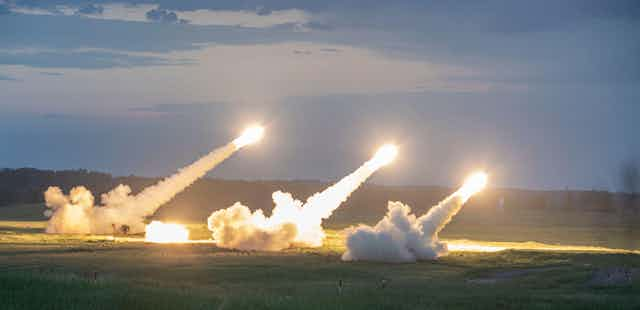There’s recently been a shift in the tactics used by both sides in the Ukraine war, due largely to the arrival of new weapons. Initially after Russian troops crossed over into Ukraine on February 24, Ukrainian armed forces engaged in a masterful defensive strategy, using British-made NLAW anti-tank missiles among others to destroy Russian armour, thereby preventing troops from entering Kyiv.
The tide then turned as Russian armed forces turned to its heavy artillery to strategically target the opposing side as well as civilians. The decision to focus on the Donbas region was partly made to support the Russian decision to focus on artillery, as its armed forces have been deployed there since 2014 and know the area well.
The Ukrainian armed forces now believe they are in position to push the Russian wave back in the south – eventually all the way back into Russia. The battle for Kherson, in the south of Ukraine, could be key in this new strategy. It could provide the Ukrainian armed forces with a window of opportunity to begin claiming back territories where Russians are deployed – and perhaps other territories that local pro-Russian groups seek to identify as theirs.
This renewed optimism is due to Ukrainian gunners being given eight Himars multiple rocket launchers by the US with the promise of more to come. This has enabled Ukraine’s military to go more on the offensive. Instead of being forced into holes by Russian artillery and only having limited weaponry with which to effectively strike back, Ukrainians are now able to destroy ammunition depots, radar, artillery positions and from a longer range.
Read more: Ukraine war: the US and UK missile systems which will challenge Russia's artillery dominance
There are rumours that Russia had to pull some of its troops from Syria to recommit to the aggression against Ukraine. The western media is also reporting US estimates of heavy losses on the Russian side. There have been signs that much of Russia’s artillery is either damaged or over-used.
Meanwhile, Ukraine’s plans to tackle Russia’s private security military company, the Wagner Group shows a more aggressive intent from Ukrainian defenders. And its destruction of the strategic Antonivskyi Bridge, was a successful demonstration of the effectiveness of the new weapons systems in Ukraine’s arsenal.
Destination Kherson
In that regard, Kherson, which has been occupied since early March 2022, is a critical target for Ukraine. The city is very important for several reasons. Firstly, the control of Kherson means having access to harbours from which Ukraine could export goods, including grain, again. Russia’s endgame seems to be to control territory as far as Moldova, to link with pro-Russian separatists in the breakway republic of Transnistria and to deny Ukraine access to the Black Sea.
Read more: Ukraine invasion: 'stage two' of Russia's war is ringing alarm bells in nearby Moldova – here's why
So it’s crucial that Ukraine can prevent this with an offensive in the Kherson region, which would prevent Russian controlling the south coast, including Odesa. The critically important port city was recently targeted by Russian airstrikes, shortly after a deal was struck between Ukraine and Russia to allow grain shipments to resume.
Winning Kherson back would also be a signal to Russia that occupying a region is quite different from maintaining control and actually running it administratively. Reports from occupied Kherson suggest a human emergency developing. There are reports of kidnapping and torture of civilians but also forced enrolment of male adults in the Russian forces.
The region would be a key part of the liberation and de-Russification of the south of Ukraine. And there are some key targets, such as Kherson’s massive hydroelectric power which supplies fresh water to 85% of Russian-occupied Crimea. Retaking the region would also hand Ukraine control of the M14/P47 highway, allowing it to block Russian access to Zaporizhzhia nuclear power plant – the largest in Europe.
Finally, if the Ukrainians retake Kherson it would be an enormous blow to Russian morale.
To do so, Ukraine will need many more weapons, particularly drones, which are invaluable not only for reconnaissance but also for mounting attacks on personnel and equipment.
But the recent Astana group summit in Tehran with Russia, Iran and Turkey, could represent a setback. There have been reports that the Iranians will supply Russia with drones. And it is unclear what will happen with the state-of-the-art Bayraktar UAVs Ukraine was hoping to acquire from Turkey.
Limited information has emerged from the summit about what was agreed on the provision of drones. Reports now say that Ukraine is working hard to acquire these UAV systems from other sources.
Long war ahead
So far, Ukraine has liberated 44 villages and towns in the Kherson oblast in a clear demonstration that the weapons supplied by the west have had an impact. This surge forward was enabled by western-supplied artillery that are more accurate over longer distances.
If and when it retakes Kherson, one of the issues the Ukrainian authorities will face is to understand why the oblast fell so quickly into Russian hands, which means investigating the possibility of collusion by local officials and leaders.
The recent decision by the Ukrainian president, Volodymyr Zelensky, to sack his security chief and the country’s top prosecutor suggests that there is some evidence (what, we don’t yet know) that their departments may have been corrupted in some way. Whether the individuals concerned had any part in that is unclear, but they have been forced to take responsibility with their jobs.
It’s hard to tell where things are headed in Ukraine at the moment. Local people I speak to daily are resigned to talking about a long war. Ukrainians are exhausted, but their anger at the invasion and their motivation to regain their whole territory has not changed and there seems little doubt that as long as they can get hold of enough weapons to resist Russian violence, they will continue to fight.

